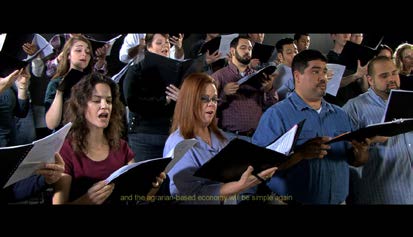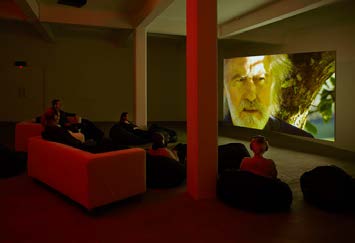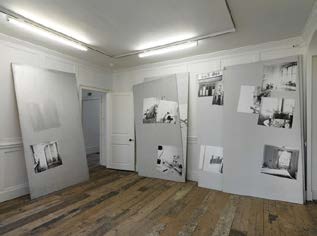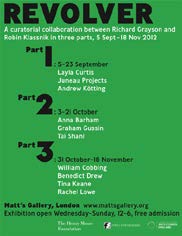Challenging our expectations: presenting alternative narratives and world views through artistic production and curation
Submitting Institution
Newcastle UniversityUnit of Assessment
Art and Design: History, Practice and TheorySummary Impact Type
CulturalResearch Subject Area(s)
Studies In Creative Arts and Writing: Film, Television and Digital Media
Language, Communication and Culture: Literary Studies
History and Archaeology: Historical Studies
Summary of the impact
Through the public exhibition of his own video practice and his dialogic
approach to the presentation of other artists' works Richard Grayson's
research projects as an artist-curator have impacted significantly on cultural
life and public discourse around contemporary visual arts in
the UK and internationally. Specifically his research has:
a) provided opportunities for audiences to experience new artworks and
exhibitions which question conventional social narratives and world views;
b) through exhibitions, critical writing and gallery discussions,
contributed to the development of public understanding of contemporary
visual art.
This case study focuses particularly on the positive critical reception
and longer-term impacts generated by Grayson's video work, The Golden
Space City of God (2009) and two recent curatorial projects, Polytechnic
(2011) and Revolver (2012).
Underpinning research
Richard Grayson undertakes practice-based research as an artist-curator.
He joined the Newcastle University Fine Art department as an AHRB Research
Fellow in 2003 and since 2007 holds a permanent position at the university
as Bartlett Research Fellow. The reach and significance of Grayson's
research is evidenced by the positive critical reception of his artworks
and curated exhibitions within the international arts press and by
on-going invitations to work with respected galleries in the UK and
abroad, including his recent high profile appointment as Curator of the
Adelaide International 2014, Australia.
Grayson's artistic and curatorial research interrogates personal belief
systems and the ways that art practices act as a point of translation
between subjective, individual views of the world and wider societal
models. The research focuses primarily on the idea of alternative
narratives: be these fantastical, philosophical, psychological or
theological. It also interrogates key dualities in art history and theory,
such as the tensions between the narratives of the Western rationalist
tradition and faith-based systems and ideologies.


In his own video works, such as The Golden Space City of God
(2009) (pictured above left, video still) (1), for example,
Grayson is specifically interested in exploring and interrogating the
apocalyptic prophecy of Christian religious sects, and the broader
political agency of the Christian Right. Through image, words and music,
these videos examine the role of language as a tool for making sense of
the world and the ways that cultural expression creates a flow from
subjective and personal constructions into the wider social realm: For The
Golden Space City of God, Grayson created a choral work using text
from a Christian cult website which detailed predictions of events leading
up to the end of the world; In The Magpie Index (2010) (pictured
above right, installation, Matt's Gallery) (2), Grayson explored
the ways in which idiosyncratic visions are developed and how these might
shape the shared beliefs of a cultural movement. Based on the life of
singer Roy Harper the work moves from the biographical to the social
presenting Harper in the frame of the radical non-conformist, the
visionary and the outsider.
This research into personal and social narratives, and the power play
between artists, art objects and audiences, is further articulated in
Grayson's curatorial projects, the Arts Council and Hayward Gallery
touring survey shows This Will Not Happen Without You (3)
and A Secret Service (both 2006/07) (4), and
gallery exhibitions, Polytechnic (2010) (5) and Revolver
(2012) (6); This Will Not Happen Without You analysed the
evolution of the six-artist collective The Basement Group into the
artist-led agency Projects UK, and Locus+; A Secret Service: Art,
Compulsion, Concealment presented works by 15 international artists
whose practices operate on different constructions of audience, exploring
the idea of secret, hidden and private worlds (artists included Sophie
Calle, Susan Hiller, Kurt Schwitters and Oskar Voll); Polytechnic
showed how personal and political concerns informed by the radical
politics of the 1970s-80s influenced artists' engagement with experimental
media (artists included Ian Breakwell, Marc Camille Chaimowicz, Catherine
Elwes, and Stuart Marshall); while Revolver worked to generate
shifting associations over time and space between ten emerging and
established artists, combining existing and newly commissioned work from
1983-2012, (artists included William Cobbing, Layla Curtis, Graham Gussin,
Juneau Projects, and Rachel Lowe, and Tai Shani).
References to the research
Artworks by Richard Grayson:
(1) The Golden Space City of God, commissioned by Art
Pace, San Antonio, USA and Matt's Gallery London (2009) http://vimeo.com/41554274
Curatorial projects:
Grants:
• Australia Council Bursary: `Messiah' (2004) A$30k
• AHRC: `New Cathedral: an investigation into the social construction of
belief systems and the contemporary video installation.' (2009) £16k. (PI:
Richard Grayson)
• Arts Council England: New work Grant (2009), £5k;
• ArtPace Texas, USA: `New Cathedral' International residency (2009)
60kUS$
• Henry Moore Foundation: (2009) £6k
• Arts Council England Grant: `This Will Not Happen Without You',
(2006-7) £50k (with Locus+)
• Henry Moore Foundation: `Revolver' (2012), £8k (with Matts Gallery)
Details of the impact
Impact on UK and international cultural life: new artistic expression
and interpretation
New artistic expression: Grayson's art
works have been widely exhibited and have been experienced by a broad
international audience. For example, his video The Golden Space City of
God has been showcased internationally at: Te Tuhi Centre for the
Arts, Manukau City, New Zealand (attracts 170,000 visitors annually); Art
Pace, San Antonio, Texas, USA; Matt's Gallery, London (all 2009);
Kunstmuseum des Kantons Thurgau, Switzerland; Yuill/Crowley Gallery,
Sydney, Australia (both 2010); the Kiev Biennale 2012 (135,000 visitors);
at Choral Visual: The Seimans Foundation, Beunos Aires and His Master's
Voice, Hanover Media KunstVerein, Germany (2013). The Golden Space
City of God was nominated as the standout show of 2009 by Time Out,
London's influential listings magazine. Art Critic Gabriel Coxhead wrote:
"Grayson's filmed libretto, compiled from online millennialist prophesy,
was by turns majestic and melancholic, amusing and terrifying..." (IMP1).
Meanwhile Waldemar Januszczak, reviewing this work in the Sunday Times,
described it as: "startling, shocking, distressing, unforgettable." (IMP2).
Extracts from a selection of Grayson's video works are also accessible
online e.g. via the popular video sharing sites YouTube and Vimeo, making
his work available to audiences beyond the gallery exhibition world. For
example: The video of Grayson's introduction to Messiah in Sydney
(www.youtube.com/watch?v=-0nNadFyfuE)
has 381 views to date; An extract from Grayson's work The Magpie Index
has 465 views , one viewer commenting that the work is: "Absolute genius
the piece resounds with common sense and intellect, reassuring there are
others with these views ;)" (IMP3).
The artistic value and importance of these works is evidenced in
purchases by prestigious collections in the UK and in Australia.The
Golden Space City of God was acquired for the Arts Council
Collection in 2010 and subsequently by the Art Gallery of Western
Australia (AGWA) for its international collection. Messiah was
also purchased for AGWA, after its re-presentation in `Songs of Survival'
at the 2010 Sydney Biennale.
Re-evaluation of British art and artists: Grayson's curated group
show `Polytechnic' at Raven Row, 2011, (pictured below left, work by Marc
Chaimowicz) presenting a re-evaluation of British video and mixed media
art from 1970s-80s, was selected by the prestigious international art
magazine Frieze (readership 71,000) as one of the most important moving
image exhibitions of 2011: "Artist Richard Grayson curated a show that
asked us to re-examine what British art - and Britain generally - looked
like in the late 1970s and early '80s....In common with many of the year's
best moving-image-related shows and screenings, `Polytechnic' taught us
how much we still have to learn about the history of film and video's
dialogues with the other arts.' (Mike Sperlinger Best of Year Frieze
Magazine 2011 Issue 136.) (IMP4).



New curatorial models: Grayson's curatorial collaboration with
Robin Klassnik (Director, Matt's Gallery), the three-part exhibition
`Revolver', (pictured above, right, work by Juneau Projects) was the first
of a new series of discursive and experimental initiatives for the
gallery. Klassnick confirmed that `Revolver' was a "developmental and
experimental curatorial project investigating and effecting new ways of
working for the organisation [Matt's Gallery]. This new working model was
an integral part of our successful National Portfolio bid to Arts Council
England in 2011 [...] the success of the collaboration [with Grayson] has
significantly informed the future operations of the organisation as it
offered possibilities of creating a hybrid operation, a site for
cross-pollination and new inputs" (IMP5). Partly a response to the
new reduced funding climate for the arts this exhibition broke away from
Matt's' more usual long-term commissioning approach to solo
exhibition-making, to present a sequence of older and recent works by ten
very contrasting artists in three consecutive mini-exhibitions.
The international significance and impact of Grayson's curatorial
approach has been recognized in his recent appointment as Curator of the
Adelaide International 2014, Australia. Announcing this appointment in May
2013, Adelaide Festival Artistic Director David Sefton commented on the
value that Grayson's eclectic curatorial approach would bring to the wider
festival, saying: "I wanted to find someone to curate Adelaide
International that would work in collaboration to bring the performing and
visual arts in the festival closer together" (IMP6).
Impact on public discourse: developing public understanding of
contemporary arts practice
Published critical writing: As a
curator Grayson is an active voice in published critical debate around the
contemporary visual arts. He is a regular contributor to Art Monthly
(the leading UK contemporary art magazine, readership 20,000) and
Broadsheet magazine (Australia). His essay `So Here we are the end Planet
Finance' (first published in Broadsheet Australia and Art Monthly) was
widely circulated on the internet, with over 1964 online `reads' to date (IMP7).
The recognition and influence of Grayson's curatorial approach is also
evidenced by frequent invitations by galleries to write for other artists'
catalogues. These include catalogue essays for: Susan Hiller, Tate
Britain; Mike Nelson, Whitechapel Art Gallery; Mark Wallinger, Aargauer
Kunsthaus, Switzerland.
Public arts debate: Grayson's artistic and curatorial projects
have been widely discussed contributing to international public debate on
the contemporary visual arts, including in the influential publications Art
Monthly, Artforum, Frieze, and Art in America (IMP8).
As deliberately provocative pieces, Grayson's own artworks have generated
debate within and beyond his immediate gallery audience, particularly
among those with religious beliefs, for example. The exhibition of his
work Messiah at the De La Warr Pavilion (2010) stimulated a
commentary on the De La Warr gallery blog about the way the work had
challenged discussion among a group of Christian visitors (O' Donoghue, http://dlwp.blogspot.co.uk/2010_02_21_archive.html).
Writing about Grayson's The Golden Space City of God for the
journal Art and Christianity Joseph Watson (V&A curator and an arts
advisor to St Paul's Cathedral) wrote: "[this work] calls us not only to
re-examine our own beliefs....but identifies the powerful role sound and
space have held in religion and the formation of collective identities. If
churches and cathedrals have provided the history of the relationship of
sound and space, is it the case that spaces of art will become (perhaps
already are) the future prophetic spaces of our culture; the communal
spaces of harmony and dissonance?" (IMP9).
Beyond the exhibition of his own and others' artworks, Grayson also has
active interaction with public audiences through lectures, artist
interviews and participation in panel discussions and research conferences
(e.g.: Venice Biennale, 2013; Marginalia, Cambridge School of Art, Anglia
Ruskin University, 2011; Chisenhale Gallery, London, 2010; Tate Modern,
2009; Tate Liverpool, 2008.) These events attract a broad arts audience,
including artists, students and curators as well as more general gallery
visitors.
Sources to corroborate the impact
(IMP1) Magazine article: Time Out Best of the year '09, 17—30 December
2009. Available on request.
(IMP2) Review: Waldemar Januszczak, `Give credit to the crunch' Sunday
Times, (17 May 2009). Review of The Golden Space City of God,
Matt's Gallery, London (2009). Available on request.
(IMP3) Views and viewer comment on Grayson's video work The Magpie
Index. Available at: www.youtube.com/watch?v=pPUmBUFjVcQ.
(IMP4) Press file: reviews of the exhibition `Polytechnic', Raven Row,
(2011). Quote (p.3).
(IMP5) Factual statement from Director, Matt's Gallery.
(IMP6) Media release: `2014 Adelaide Biennial and Adelaide International
Curators Announced'. (13 May 2012). Quote from David Sefton, Adelaide
Festival 2014 Director, on Richard Grayson's appointment.
(IMP7) Online essay by Richard Grayson: `So Here we are the end Planet
Finance'. Available at: http://undergrowth.org/the_end_of_planet_finance_richard_grayson
(IMP8) Richard Grayson Selected Bibliography: A list of exhibition
reviews 2008-2012.
(IMP9) Exhibition review: Watson, J (2009) `The Golden Space City of
God', Art and Christianity (No.59, Autumn). Available on request.